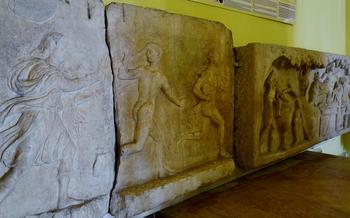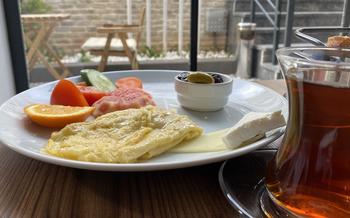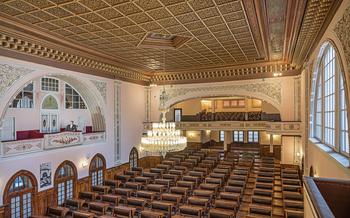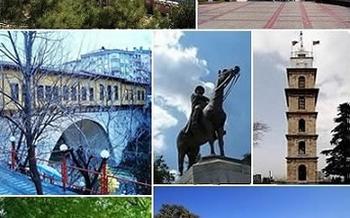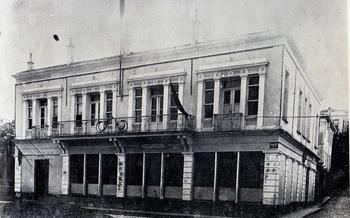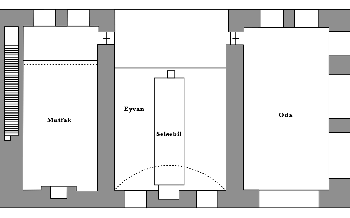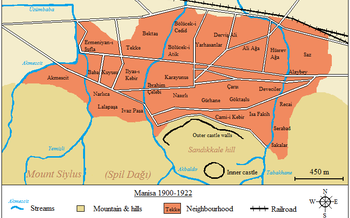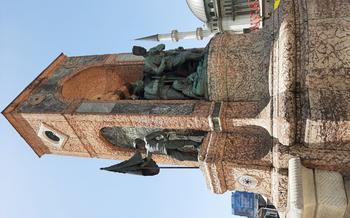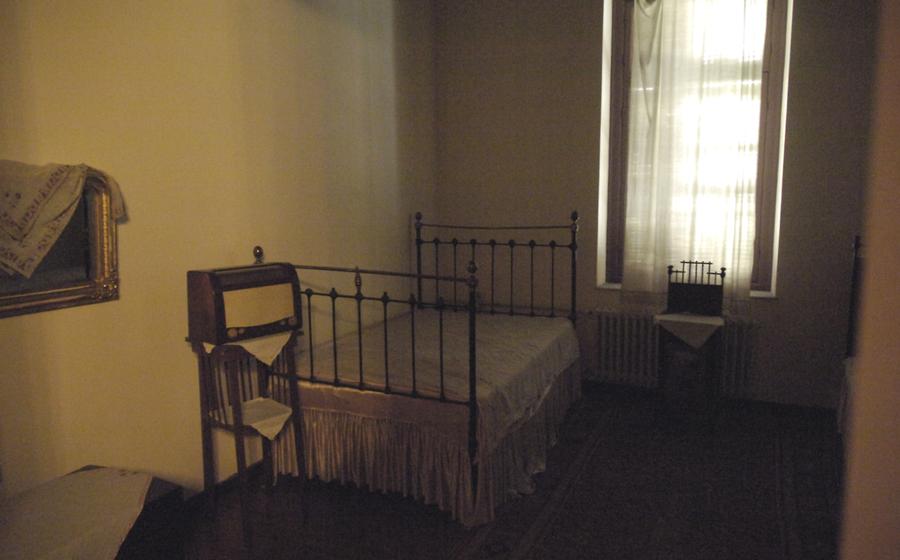
Atatürk House Museum
- Atatürk House Museum: A Glimpse into the Life of a Turkish Statesman
- Explore the Museum's Grounds: A Serene Oasis in Mersin
- Step Inside the Museum: A Journey Through Atatürk's Life
- Learn About Atatürk's Childhood and Early Life
- Discover Atatürk's Vision for a Modern Turkey
- Witness Atatürk's Personal and Leadership Qualities
- Understand Atatürk's Legacy and Impact on Turkey
- Take a Moment to Reflect: The Significance of Atatürk's House
- Capture the Moment: Photography Tips for Visitors
- Souvenirs and Mementos: Preserving Your Memories of the Museum
- Explore Mersin Beyond the Museum: Unveiling a Historic City
- Transportation Tips: Getting to and Around Mersin
- Insider Tip: Unveiling a Hidden Gem
Atatürk House Museum: A Glimpse into the Life of a Turkish Statesman
The Atatürk House Museum, situated in the vibrant city of Mersin, Turkey, offers a profound journey into the life and legacy of Mustafa Kemal Atatürk, the revered founder of the Turkish Republic. Originally built in 1865, this historic residence was meticulously restored and transformed into a museum in 1940, preserving the essence of Atatürk's time spent in Mersin during the Turkish War of Independence.
As you step through the gates of the museum, you'll be greeted by a serene and meticulously maintained garden, a testament to Atatürk's love for nature and tranquility. The architectural style of the house, a blend of Ottoman and European influences, reflects the cultural crossroads that Mersin has always been.
In addition to its historical significance, the museum's location offers stunning views of the Mediterranean Sea, making it an ideal destination for history and nature enthusiasts alike. Easily accessible by public transportation or car, the Atatürk House Museum stands as a beacon of Turkish history, inviting visitors to delve into the life of a remarkable leader who shaped the course of a nation.
Explore the Museum's Grounds: A Serene Oasis in Mersin
Step outside the museum building and immerse yourself in the tranquility of the surrounding gardens. Landscaped with meticulous care, these green spaces offer a welcome respite from the bustling city. Stroll along the winding paths, admiring the vibrant flowers, lush trees, and manicured hedges.
Cool off beside the refreshing fountains and water features, listening to the gentle sound of trickling water. Take a seat on one of the many benches, letting the tranquility of the surroundings wash over you. As you gaze out towards the Mediterranean Sea, let your mind wander and appreciate the beauty of this serene oasis.
Step Inside the Museum: A Journey Through Atatürk's Life
Beyond the threshold of the Atatürk House Museum, visitors embark on a captivating journey through the life and legacy of this revered Turkish statesman. The museum's meticulously curated displays showcase a treasure trove of personal belongings and artifacts that once graced Atatürk's presence. From his military uniforms to his collection of books and writing instruments, each item holds a poignant story, offering glimpses into his character and passions.
Documents and photographs adorn the walls, narrating the milestones of Atatürk's remarkable life. Visitors can trace his footsteps from his childhood in Thessaloniki to his pivotal role in the Turkish War of Independence and his subsequent leadership as the founder of the Turkish Republic. Interactive exhibits and displays bring history to life, engaging visitors with multimedia presentations and immersive experiences.
Guided tours, led by knowledgeable and passionate docents, provide an enriching narrative that delves into the complexities of Atatürk's personality and his profound impact on Turkey. Visitors are invited to ask questions, fostering a deeper understanding of the man who shaped the course of Turkish history.
Learn About Atatürk's Childhood and Early Life
Atatürk's formative years played a crucial role in shaping the man who would later become the father of modern Turkey. Born in Thessaloniki, then part of the Ottoman Empire, in 1881, Mustafa Kemal Atatürk came from a humble background. His father, Ali Rıza Efendi, was a customs official, and his mother, Zübeyde Hanım, was a devout Muslim woman.
Atatürk's childhood was marked by tragedy when his father passed away at an early age. This loss had a profound impact on the young Mustafa, who developed a strong sense of independence and self-reliance. He excelled in his studies, showing a particular aptitude for mathematics and science.
At the age of 12, Atatürk enrolled in the prestigious Monastir Military School, where he received a rigorous education in military strategy and tactics. He quickly rose through the ranks, demonstrating exceptional leadership qualities and a keen intellect. His military career would eventually lead him to play a pivotal role in the Turkish War of Independence, which would ultimately result in the establishment of the Turkish Republic.
Discover Atatürk's Vision for a Modern Turkey
Atatürk's vision for a modern Turkey was transformative and far-reaching. He embarked on a series of bold reforms aimed at modernizing the country's political, social, and economic structures. His reforms extended to all aspects of Turkish society, from education and healthcare to the legal framework and the role of women.
Atatürk believed that education was the key to progress, and he worked tirelessly to expand access to education for all citizens. He established new schools and universities, and he introduced reforms to the education system to make it more modern and relevant to the needs of a changing society.
In the realm of social reforms, Atatürk abolished the caliphate and introduced a secular legal code based on the Swiss Civil Code. He also promoted gender equality, granting women the right to vote and to hold public office. These reforms were groundbreaking for their time and laid the foundation for a more modern and progressive Turkish society.
Atatürk's economic reforms focused on developing Turkey's infrastructure and promoting industrialization. He initiated major infrastructure projects, such as the construction of roads, railways, and dams, to connect different parts of the country and facilitate trade and commerce. He also encouraged the development of domestic industries to reduce reliance on imported goods and to boost the country's economy.
Atatürk's vision for a modern Turkey was ambitious and challenging, but he was determined to transform the country into a thriving and prosperous nation. His reforms laid the foundation for the modern Turkish Republic and continue to shape the country's development to this day.
Witness Atatürk's Personal and Leadership Qualities
Atatürk's personal and leadership qualities were instrumental in shaping the course of Turkish history. His unwavering courage and determination were evident in his relentless pursuit of independence and modernization. As a military strategist, he displayed exceptional decision-making skills and a keen ability to adapt to changing circumstances.
Atatürk's charisma and oratorical skills enabled him to inspire and unite a nation. He possessed an uncanny ability to connect with people from all walks of life, earning their trust and admiration. His vision for a modern and progressive Turkey was contagious, and he motivated an entire nation to strive for excellence.
His strategic thinking and decision-making abilities were critical in the success of the Turkish War of Independence. Atatürk's leadership during this tumultuous period was characterized by his ability to assess complex situations, make decisive choices, and maintain a clear focus on his ultimate goal of independence.
Atatürk's personal qualities, including his integrity, honesty, and unwavering belief in the potential of his people, set him apart as an exceptional leader. He led by example, embodying the values he espoused, and his dedication to serving his country was unwavering.
Understand Atatürk's Legacy and Impact on Turkey
Atatürk's legacy extends far beyond his lifetime, leaving an indelible mark on Turkey's history and identity. As the founding father of the Turkish Republic, he is revered as a symbol of national unity and progress. His vision of a modern, secular, and democratic Turkey transformed the nation, propelling it into the 20th century.
Atatürk's leadership and reforms had a profound impact on Turkish society. He introduced legal and social changes, such as granting women the right to vote and abolishing the caliphate. He also focused on economic development, establishing industries and modernizing infrastructure. His efforts laid the foundation for Turkey's subsequent growth and prosperity.
To this day, Atatürk remains a deeply respected and admired figure in Turkey. His image is displayed prominently in government buildings, schools, and public spaces. His mausoleum in Ankara is a national pilgrimage site, attracting millions of visitors annually. Atatürk's legacy continues to inspire generations of Turks, serving as a reminder of the transformative power of leadership and vision.
Take a Moment to Reflect: The Significance of Atatürk's House
The Atatürk House Museum stands as a poignant reminder of the deep connection between Atatürk and the Turkish people. It was here, within these walls, that he lived and worked, tirelessly dedicating himself to the betterment of his nation. The museum offers a glimpse into his personal life, revealing the qualities that made him an extraordinary leader and a beloved figure in Turkish society.
As you wander through the rooms, take a moment to reflect on the significance of this place. Imagine Atatürk sitting at his desk, poring over maps and documents, strategizing for the future of Turkey. Picture him receiving guests, engaging in discussions, and making decisions that would shape the course of history.
The Atatürk House Museum is not just a historical site; it is a symbol of Atatürk's dedication to serving Turkey. It represents his unwavering commitment to progress, modernization, and the well-being of his people. For many Turks, visiting the museum is akin to a pilgrimage, a chance to pay homage to the man who led their nation to independence and laid the foundation for its modern identity.
Capture the Moment: Photography Tips for Visitors
The Atatürk House Museum is a treasure trove of history and heritage, and capturing the essence of this remarkable place through photography is an opportunity not to be missed. Here are some photography tips to help you capture the best shots:
-
Choose the Right Angle: Experiment with different angles to find the most flattering perspective for your photos. Consider shooting from above or below to add depth and interest to your shots.
-
Harness the Light: Natural light is your best friend when it comes to photography. Plan your visit during the "golden hours" of sunrise or sunset to capture the warm, diffused light that will enhance the colors and textures of the museum and its surroundings.
-
Respect Visitor Privacy: Remember that the museum is a place of reflection and reverence, so be mindful of other visitors when taking photos. Avoid capturing people's faces or personal moments without their consent.
-
Focus on Details: The museum is filled with intricate details that tell a story. Zoom in on small objects, such as Atatürk's personal belongings or the architectural elements of the building, to create intimate and evocative images.
-
Compose a Narrative: Think of your photos as part of a larger narrative about Atatürk's life and legacy. Arrange your shots to create a cohesive story that allows viewers to connect with the museum's significance.
Souvenirs and Mementos: Preserving Your Memories of the Museum
The Atatürk House Museum offers a variety of souvenirs and mementos that allow visitors to preserve their memories of this historic site. The museum gift shop is located near the exit and features a selection of items inspired by Atatürk's life and legacy.
From books and postcards to replicas of artifacts, there is something for every taste and budget. Visitors can purchase biographies, historical accounts, and personal anecdotes to delve deeper into Atatürk's remarkable life. Postcards showcasing the museum's exhibits and the surrounding landscapes serve as a tangible reminder of the visit.
For those seeking unique souvenirs, the gift shop offers replicas of Atatürk's personal belongings, such as his signature fez hat and his pocket watch. These high-quality replicas are crafted with attention to detail and make for cherished keepsakes.
When selecting souvenirs, it is essential to consider items that hold personal significance. Whether it's a book that resonates with your interests or a replica that symbolizes Atatürk's legacy, choose something that will evoke fond memories of your visit to this exceptional museum.
Explore Mersin Beyond the Museum: Unveiling a Historic City
Beyond the walls of the Atatürk House Museum, Mersin beckons visitors to delve deeper into its rich tapestry of history, culture, and natural beauty. A short walk from the museum leads to the heart of the city, where ancient ruins stand side-by-side with modern landmarks. The Mersin Archaeological Museum houses an impressive collection of artifacts that narrate the city's ancient past, shedding light on its role as a significant port city in the Mediterranean.
For those seeking a spiritual connection, the Grand Mosque of Mersin, with its towering minarets and intricate Islamic architecture, offers a profound experience. History enthusiasts can embark on a journey through time at the Mersin City Museum, where exhibits showcase the city's transformation from a small fishing village to a bustling metropolis.
Mersin's culinary scene is a delight for foodies, with traditional Turkish dishes blending harmoniously with international flavors. From freshly caught seafood to mouthwatering kebabs, Mersin's restaurants offer a culinary adventure that tantalizes the taste buds.
Finally, no visit to Mersin is complete without experiencing its vibrant cultural scene. From traditional dance performances to art exhibitions, Mersin's cultural calendar is filled with events that showcase the city's rich heritage.
Mersin, a city that seamlessly blends the charm of the past with the dynamism of the present, promises an unforgettable experience for travelers seeking history, culture, and authentic Turkish hospitality.
Transportation Tips: Getting to and Around Mersin
Mersin is well-connected to the rest of Turkey and the world by air, land, and sea. The city's international airport, Mersin Adana Airport, offers direct flights to major cities in Turkey and Europe. From the airport, you can take a taxi or bus to the city center, which takes about 45 minutes.
Once in Mersin, getting around is easy and affordable. The city has an efficient public transportation system, with buses and trams connecting all major neighborhoods. You can also rent a car to explore the city and its surroundings at your own pace. Parking is generally easy to find in Mersin, except during peak tourist season.
If you're staying in the city center, most attractions are within walking distance or a short bus ride away. However, if you plan on exploring the outskirts of Mersin or neighboring towns, renting a car is the best option.
Here are some tips for getting around Mersin:
-
Taxis: Taxis are readily available in Mersin and are a convenient way to get around. Make sure to agree on a fare before getting in the taxi.
-
Buses: Buses are the most affordable way to get around Mersin. They run frequently and cover most parts of the city.
-
Trams: Trams are a good option for getting around the city center. They are reliable and run on time.
-
Car rental: Renting a car is a great way to explore Mersin and its surroundings at your own pace. Several car rental companies are available at the airport and in the city center.
-
Parking: Parking is generally easy to find in Mersin, except during peak tourist season. There are several public parking lots in the city center, as well as on-street parking.
Insider Tip: Unveiling a Hidden Gem
As you explore the Atatürk House Museum, keep an eye out for hidden treasures that reveal the essence of Atatürk's life and legacy. Within the museum grounds, tucked away among the lush gardens, you might stumble upon a serene reflection pool that mirrors the beauty of the surrounding architecture. This tranquil spot invites you to pause and reflect on Atatürk's vision for a peaceful and prosperous Turkey.
Venture beyond the museum walls to uncover Mersin's hidden gems. Immerse yourself in the vibrant local markets, where you can haggle for unique souvenirs and savor the aromas of traditional Turkish cuisine. Engage with the friendly locals, who will gladly share stories and insights about Atatürk's impact on their lives and the city's rich history.
For a truly authentic experience, step off the beaten path and explore the charming coastal towns and villages that dot Mersin's stunning coastline. Discover secluded beaches, where you can bask in the Mediterranean sun and swim in the crystal-clear waters. Indulge in fresh seafood delicacies at local restaurants, while enjoying breathtaking views of the sparkling Mediterranean Sea.
Whether you're seeking moments of tranquility, cultural immersion, or outdoor adventures, Mersin offers a wealth of hidden gems waiting to be discovered. Embrace the spirit of exploration, embrace the rich stories that this city holds and create lasting memories that will stay with you long after your visit.

